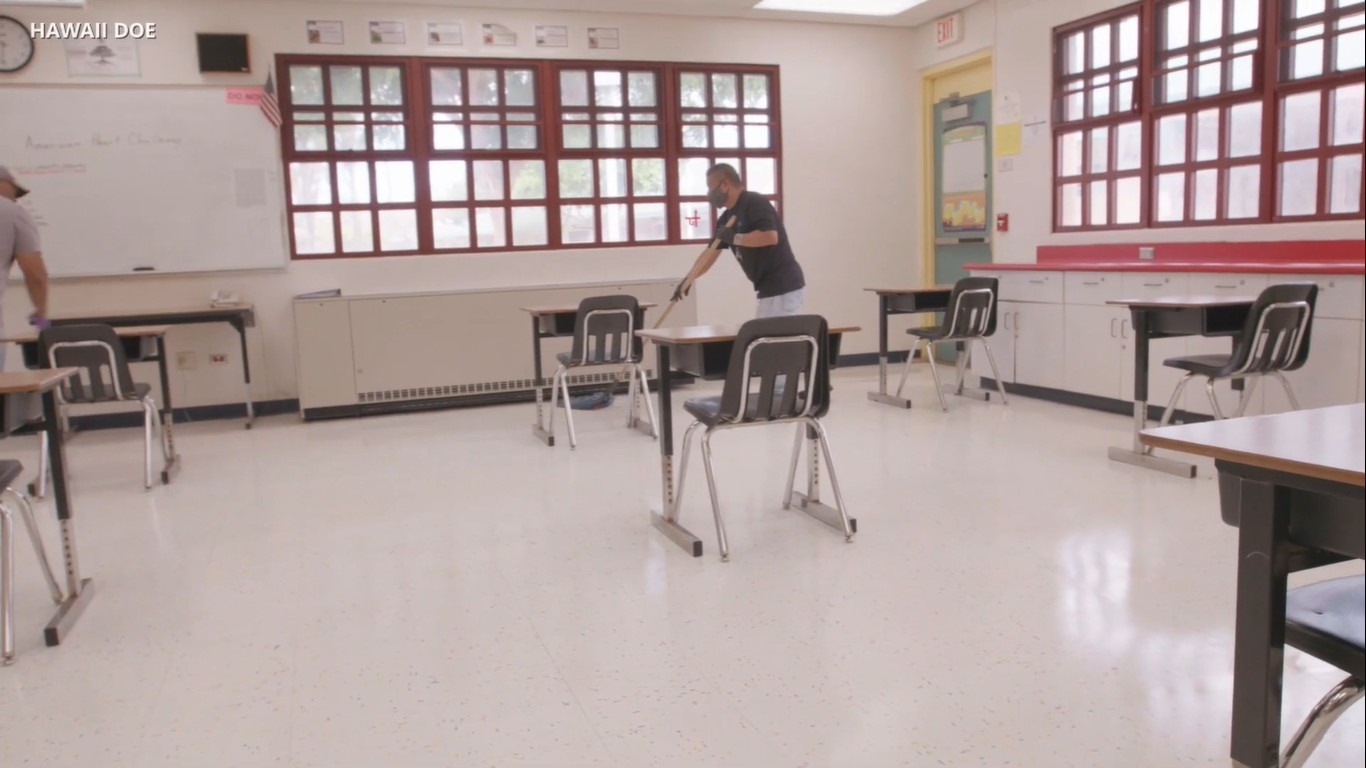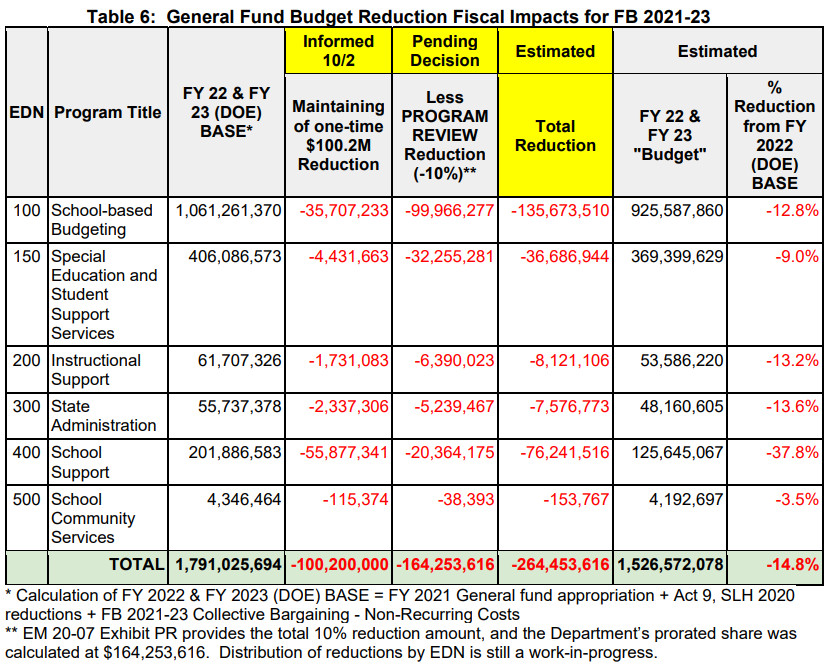Video by HSTA, livestreamed on December 2, 2020.
(BIVN) – On the even of an important Hawaiʻi Board of Education meeting to approve a COVID-impacted budget for the upcoming fiscal year, the Hawaiʻi State Teachers Association is raising concerns over the “damaging impacts” the spending cuts might have on schools.
“The department of education has cut its budget in order to meet Governor Ige’s directive,” said HSTA president Corey Rosenlee during a Wednesday news conference. “The two largest proposed cuts are a 10% percent cut to the Weighted Student Formula, and a 9% percent cut to special education.”
“The Weighted Student Formula provides every school an annual dollar amount for each student to help cover its operating costs,” Rosenlee explained. “The ten percent cut to the Weighted Student Formula and the proposed nine percent reduction to special education gives the impression that we’re only trimming the fat, downplaying the severe consequences of these two cuts. Together, these two budget cuts could mean 1,000 special education and regular education teaching positions could be lost. This would impact our keiki. Other programs – such as art, music, Hawaiian studies, Hawaiian language immersion, career and technical education, physical education – all could be reduced or eliminated. class sizes could also increase and we could see programs such as advanced placement, electives, and gifted and talented either be reduced or eliminated.”
In its submittal to the Board of Education, the Department of Education outlined its proposed budget cuts:
1.) General fund reductions of 102.5 total Full-Time Equivalents (FTEs) consisting of 95.5 permanent positions, 7.0 temporary positions and $164.3 million.
2.) Critical areas to protect:
- Safety and security of students, employees, and visitors to our facilities;
- New teacher induction program to support new teachers, which will, in turn, promote retention and ensure quality instruction and student support;
- Modernization of the Department’s systems to allow for seamless operations and a greater focus on our students (i.e. Financial Management System, Longitudinal Education Information system); and
- Online learning to provide differentiated web-based educational programming; expand the use and offerings of digital instruction; and create learning opportunities which will allow students to collaborate with students, teachers, and business and industry partners across the State.
3.) Opportunities for consolidation of programs and functions to reduce costs and increase efficiency (e.g. the Office of Strategy, Innovation and Performance is currently reviewing its branch functions to identify programs that can be consolidated). Reassessment of State office work to streamline programs and functions and remove duplicity across the three levels of the Department (e.g. the Office of Curriculum and Instructional Design will streamline its work to focus on the core work around curriculum standard setting).
4.) Review of federally mandated services provided to effectively and efficiently leverage federal funds to maintain essential functions and meet unfunded and underfunded needs while ensuring compliance.
5.) Reassessment of teacher positions in our State offices to identify which positions are essential to state level functions related to teaching and learning.
6.) Redesign of operations such as student transportation and school food service to maximize cost efficiency while improving service to students and families.
7.) Maximize the use of existing Department facilities to reduce office leases in other facilities.
The Hawaiʻi DOE also explained how an additional $100.2 million reduction – at first considered a one time-reduction but later made permanent – figure into the budget. The DOE used this graph:
The Department has four formula-based programs: Weighted Student Formula (WSF) for regular education at schools, SPED Per Pupil Allocation (SPPA) for special education classroom instruction, Indexed Complex Area Allocation (ICAA) for complex areas, and Community School for Adults (CSA) for adult education schools. These student-based, schoollevel programs comprise 73.9% of the Department’s FY 2021 general fund budget. In FY 2021, these programs were reduced by $24.2 million as part of the total $100.2 million reduction. Schools and complex areas will see these reductions carried forward as part of the 10% Program Review reductions, resulting in an estimated reduction total of about $121.9 million for FB 2021-2023.
In addition to formula-based programs, school-level funding may be budgeted in State offices and allocated to schools via categorical programs. Examples of such categorical programs include, but are not limited to, Olomana School, Niihau School, Hawaii School for the Deaf and Blind, the Hawaiian Language Immersion Program, Hawaiian Studies, alternative learning programs, athletics, the Early College Program, e-School, and School-Based Behavioral Health. Thus, reductions to state-level office budgets may impact funds that are passed through to provide direct educational support to schools and students.
Schools may be further impacted by the reductions at the State office level. Significant reductions to the Department’s budget may impact functions that have been centralized within the State offices for purposes of efficiency and cost-effectiveness, such as utilities, testing, facility maintenance, information technology support and maintenance, fiscal management systems, school food service, safety and security, and student transportation. As such, significant reductions to State offices will also impact school-level funding and operations should schools have to assume the functions that the State offices will no longer be able to sustain.
Each school completes an annual Academic Plan and Financial Plan to determine staffing and other resource needs. Further insight into how the reductions will impact schools will be available once schools complete their SY 2021-2022 staffing financial plans at the end of December.
The Hawaiʻi DOE also listed these “unknown factors” that it says “may significantly influence the Department’s final proposed” Fiscal Biennium 2021-2023 budget:
- At the Governor’s level, there are negotiations regarding employee furloughs. However, no decision has yet been made.
- In January and March 2021, the Council on Revenues will report the latest revenue forecast to the Governor and Legislature to revisit State revenue projections. The outcome of these meetings will inform the Department and other decision-makers whether more severe reductions may be considered over the legislative session.
- The Legislature will monitor the State’s economic conditions and carefully review and evaluate the Department’s budget reductions throughout the 2021 legislative session. Changes that will impact the Department’s budget are anticipated throughout the legislative process.
- The timing, form, and level of additional federal assistance to address unanticipated costs and economic fallout related to COVID-19 remains uncertain at this time. When additional federal funding is received, it is possible that funding could offset some of the reductions; however, the Department will prudently continue to look for additional options to balance the fund.
The Hawaiʻi Board of Education Finance and Infrastructure Committee will be discussing the operating budget during its meeting on Thursday, December 3. The virtual meeting will take place at 11 a.m.



by Big Island Video News3:06 pm
on at
STORY SUMMARY
HAWAIʻI - The Hawaiʻi State Teachers Association says the proposed, deep budget cuts will have "damaging impacts" on schools.